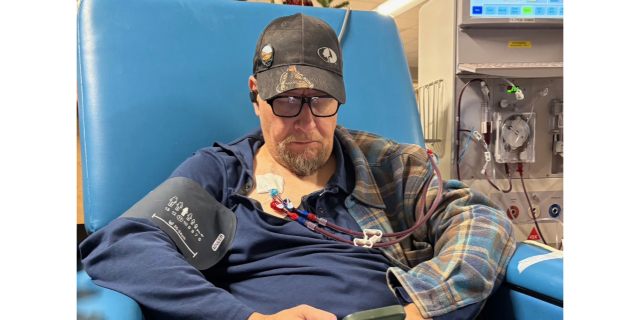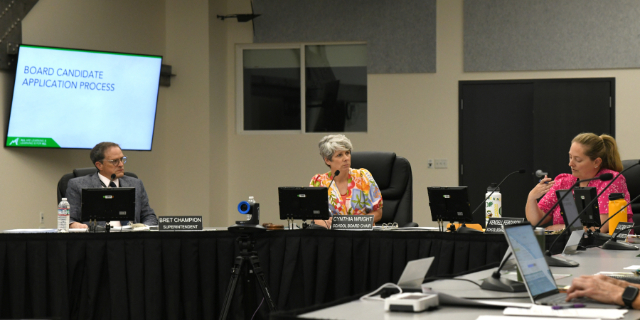Tiny owl found in Shady Cove has broken collarbone, new fame
Published 12:45 pm Saturday, January 13, 2024

- An injured Northern Pygmy-Owl found in Shady Cove on Thursday rests in a pet carrier next to an Oregon State Police patch before the bird was taken by OSP fish and game Trooper Cameron Jamison to Wildlife Images Rehabilitation and Education Center near Grants Pass. Jamison keeps patches in his vehicle to give to children interested in becoming a trooper when they grow up.
A tiny, injured Northern Pygmy-Owl found in a Shady Cove driveway is recuperating at Wildlife Images Rehabilitation and Education Center near Grants Pass. And a cute photograph of the bird is making the rounds.
It’s only a guess how the owl came to be in the driveway last Thursday. Snow may have driven it out of its usual habitat where it possibly collided with a window or vehicle.
What’s known is that a Good Samaritan protected it with a box until Cameron Jamison, a fish and wildlife trooper with Oregon State Police, arrived and took it to Wildlife Images. He also took the photo, a close-up of the bird in a pet carrier, next to an OSP patch that helps to visualize the bird’s small size.
Lindsay Magill, clinic supervisor for Wildlife Images, said on Friday afternoon that the bird had a broken coracoid, or collarbone.
“There were no fractures or dislocation in the wing, which was good,” she said when contacted by phone. “He does have a little bit of a wing droop.”
“We wrap that wing up into a normal position so that it can heal. It’s about 50-50 whether that coracoid will heal correctly.”
Capt. Kyle Kennedy, a state police spokesman, said the reporting party contacted OSP to say they found a baby owl and that it appeared to have a wing injury.
“They were able to safely secure the animal in a cardboard box with air holes until F&W Troops could respond,” Kennedy wrote in a reply to questions, after he issued a press release and photo about the owl.
“These owls are typically in mountainous areas but will come to lower elevations during heavy snow like what we’re currently experiencing.
“What likely occurred is the owl came to lower elevations to escape the heavy snow and it’s probably not used to houses or windows and unfortunately collided with a window while hunting as these birds are visual hunters so it may have been going after the reflection of something it thought was prey.”
Injured raptors are a common call handled by fish and wildlife troopers, but this was Jamison’s first encounter with a Northern Pygmy-Owl, according to Kennedy, who said the bird was about the size of a baseball or a 3-inch OSP patch.
Jamison typically keeps patches in his vehicle to give to children who express a desire to be a trooper when they grow up. The lighting in the photo is good, showing the owl and patch in clear detail. The owl appears calm as it rests on what appears to be paper towels.
Pet carriers are used to transport injured raptors and other wildlife, for their safety and the safety of officers, according to Kennedy, who added that an injured animal thrashing about will typically injure itself further.
“For raptors specifically, it is calming for them to be in a small, dark space,” he wrote. “Typically a pet carrier with a towel or sheet draped over it is perfect for this but in this case, just about any container is large compared to a Pygmy Owl.”
Magill, of Wildlife Images, said the owl’s prognosis was guarded. She probably will know in about two to four weeks how well the bird’s hollow, thin coracoid is healing.
“They heal really quickly,” she said.
If the owl was unable to fly, its ability to hunt or evade predators would be affected. The goal is to release it fully rehabilitated and in the general area where it was found, she said.
If people come across an injured animal, Magill advised that they contact Wildlife Images or another rehabilitation center.
“The first thing to always do is call your local wildlife rehabilitator,” she said. “Sometimes what looks like an injury isn’t always an injury.”
She also urged people to keep their cats inside.
“It helps our wildlife to keep your cats indoors,” she said. “The No. 1 predator is going to be someone’s domestic cat.”
In his news release, Kennedy praised wildlife rehabilitators. Wildlife Images currently is experiencing personnel issues and is closed to the public, although its animal care continues.
“We are thankful to have partnerships with nonprofit wildlife rehabilitation facilities who help save wildlife like this little Northern Pygmy Owl,” Kennedy wrote. “We appreciate the commitment of their staff, volunteers, and donors who help us fulfill our mission of preserving and protecting Oregon’s natural resources.”
Northern Pygmy-Owls are native to western North America, including forested areas of Oregon’s Coast Range, Klamath Mountains, Cascade Mountains and Blue Mountains, according to Kennedy. Unlike many species of owls, they are active during the day and hunt by sight rather than sound.
“Although small in stature, these little raptors can be fierce hunters preying on everything from mice, voles, and insects to small reptiles and amphibians such as lizards or frogs,” he said.
To report injured, sick or dead wildlife, people may contact the Oregon Department of Fish and Wildlife at 541-826-8774 in Jackson County or reach the state’s Wildlife Health Lab at 866-968-2600. Reach Wildlife Images at 541-476-0222.






